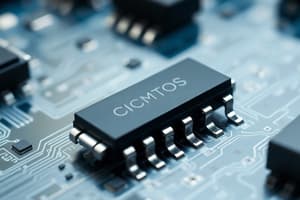Podcast
Questions and Answers
What is the purpose of MOSFET design rules?
What is the purpose of MOSFET design rules?
- To define how small features can be and how closely they can be packed (correct)
- To specify the exact placement of components in an IC
- To determine the type of FET to be used in a circuit
- To describe the manufacturing process steps in detail
Which unit process step is responsible for creating a layer of silicon dioxide on the wafer surface?
Which unit process step is responsible for creating a layer of silicon dioxide on the wafer surface?
- Lithography
- Diffusion
- Metallization
- Oxidation (correct)
What do layout design rules in IC fabrication primarily govern?
What do layout design rules in IC fabrication primarily govern?
- Choice of components in the IC
- The manufacturing cost of the IC
- The electrical properties of the IC
- The size and spacing of features in the IC (correct)
What makes migrating from one process to a more advanced process difficult?
What makes migrating from one process to a more advanced process difficult?
What is the main objective of creating stick diagrams for MOS circuits?
What is the main objective of creating stick diagrams for MOS circuits?
Why is it important to understand the capabilities and limitations of stick diagrams?
Why is it important to understand the capabilities and limitations of stick diagrams?
What does CMOS stand for in Complementary CMOS Logic Style?
What does CMOS stand for in Complementary CMOS Logic Style?
What is a key topic covered in EC303 CMOS VLSI Design?
What is a key topic covered in EC303 CMOS VLSI Design?
In building CMOS gates, what is located on the 'n-side'?
In building CMOS gates, what is located on the 'n-side'?
Which course outcome involves analyzing the performance of a CMOS inverter?
Which course outcome involves analyzing the performance of a CMOS inverter?
What is the purpose of a stick diagram in circuit design?
What is the purpose of a stick diagram in circuit design?
What are some of the design techniques covered in the course for digital circuits using CMOS?
What are some of the design techniques covered in the course for digital circuits using CMOS?
What is the purpose of studying MOSFET capacitances in EC303 CMOS VLSI Design?
What is the purpose of studying MOSFET capacitances in EC303 CMOS VLSI Design?
Which type of logic design is NOT discussed in EC303 CMOS VLSI Design?
Which type of logic design is NOT discussed in EC303 CMOS VLSI Design?
What is an essential part of the unit process steps in CMOS technology discussed in EC303?
What is an essential part of the unit process steps in CMOS technology discussed in EC303?
What is the purpose of stick diagrams in VLSI design?
What is the purpose of stick diagrams in VLSI design?
What does a poly crossing diffusion represent in a stick diagram?
What does a poly crossing diffusion represent in a stick diagram?
According to the rules of stick diagrams, what does it mean when two sticks of different types cross or touch each other?
According to the rules of stick diagrams, what does it mean when two sticks of different types cross or touch each other?
What information do stick diagrams convey through color codes or monochrome encoding?
What information do stick diagrams convey through color codes or monochrome encoding?
In CMOS stick diagrams, what is the purpose of the demarcation line drawn between p-diff and n-diff?
In CMOS stick diagrams, what is the purpose of the demarcation line drawn between p-diff and n-diff?
What aspect of MOS circuits do stick diagrams help plan and visualize?
What aspect of MOS circuits do stick diagrams help plan and visualize?
What should be the relationship between the placement of pMOS and nMOS in Stick Diagrams?
What should be the relationship between the placement of pMOS and nMOS in Stick Diagrams?
What is a key component of the physical structure of an NMOS?
What is a key component of the physical structure of an NMOS?
Which layer is not part of the implicit layers in PMOS layout representation?
Which layer is not part of the implicit layers in PMOS layout representation?
What does Leff < Ldrawn indicate in NMOS physical structure?
What does Leff < Ldrawn indicate in NMOS physical structure?
What should be the relationship between p-substrate and n+ source/drain in physical structure of pMOS?
What should be the relationship between p-substrate and n+ source/drain in physical structure of pMOS?
Which component is common in both NMOS and PMOS layout representations?
Which component is common in both NMOS and PMOS layout representations?
Flashcards are hidden until you start studying
Study Notes
EC303 CMOS VLSI Design
Course Outcomes
- Explain the fabrication, operation, and characteristics of MOSFET
- Analyze the performance of CMOS inverter
- Design digital circuits using CMOS gates
- Design analog circuits using CMOS gates
- Outline the latest trends in CMOS technology
Introduction to MOSFETs
- Unit process steps of CMOS technology:
- Wafer preparation
- Oxidation
- Lithography
- Diffusion
- Ion-implantation
- Epitaxy
- Metallization
- Fabrication process flow: NMOS, PMOS, Twin well CMOS
- Structure and operation of the MOS transistor
- I-V and CV characteristics
- MOSFET capacitances
- Layout and design rules
- Scaling and short channel effects
MOS Inverters
- Inverters with resistive, MOSFET load
- CMOS inverter: Voltage transfer characteristics
- Noise margins
- Switching characteristics
- Calculation of delay times
- Effect of load on switching characteristics and driving large loads
- Logical effort of paths
Digital Circuits Using CMOS
- Pseudo NMOS
- Pass transistor
- Transmission gates
- Dynamic logic
- Domino logic
- Differential cascode voltage switch logic
- Design of combinational circuits
- Design of sequential circuits
- Timing requirements
Analog Circuits
- Second-order effects in MOSFETs
- Single stage Amplifiers:
- Common-source stage
- Source follower
- Common-gate
- Cascode stage
- Differential Amplifiers
- Passive and Active current mirrors
- CMOS operational amplifier
- Gain boosting techniques
Trends in CMOS Technology
- SOI
- FinFET and multi-gate FET
- 2D materials-based FETs
- On-chip interconnects
Layout Design Rules
- Definition: A schematic of the Integrated Circuit (IC) that describes the exact placement of components for fabrication
- Purpose: To specify how small features can be and how closely they can be packed in a manufacturing process
- Importance: Why we need layout design rules
- Specification: Typically in microns, making it difficult to migrate to more advanced processes
Stick Diagrams
- Definition: A means of capturing topography and layer information using simple diagrams
- Purpose: Acts as an interface between symbolic circuit and actual layout
- Features:
- Does show all components/vias
- Shows relative placement of components
- Goes one step closer to the layout
- Helps plan the layout and routing
- Limitations:
- Does not show exact placement of components
- Does not show transistor sizes
- Does not show wire lengths, wire widths, tub boundaries
- Does not show low-level details such as parasitics
Drawing Stick Diagrams
- Rule 1: When two or more ‘sticks’ of the same type cross or touch each other, it represents electrical contact
- Rule 2: When two or more ‘sticks’ of different types cross or touch each other, there is no electrical contact
- Rule 3: When a poly crosses diffusion, it represents a transistor
- Rule 4: In CMOS, a demarcation line is drawn to avoid touching of p-diff with n-diff
Studying That Suits You
Use AI to generate personalized quizzes and flashcards to suit your learning preferences.




